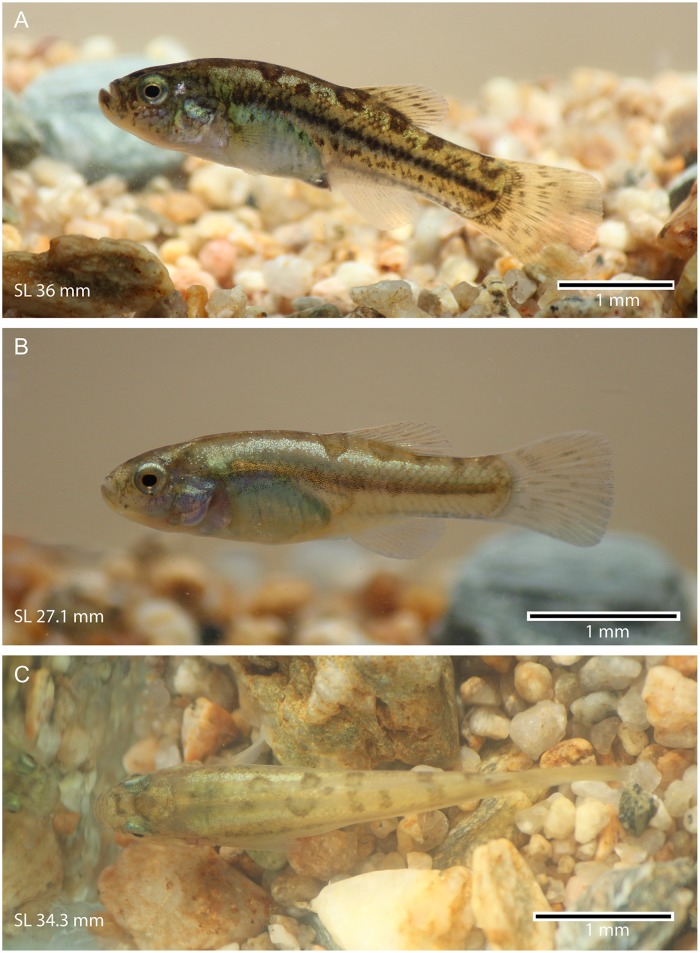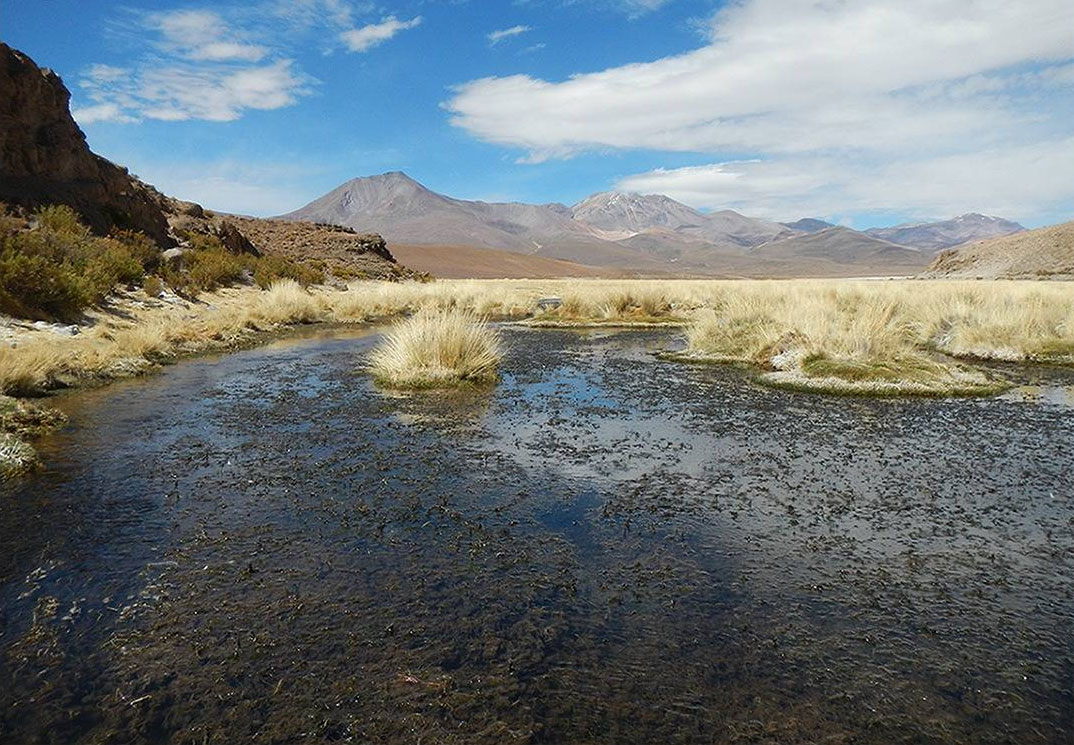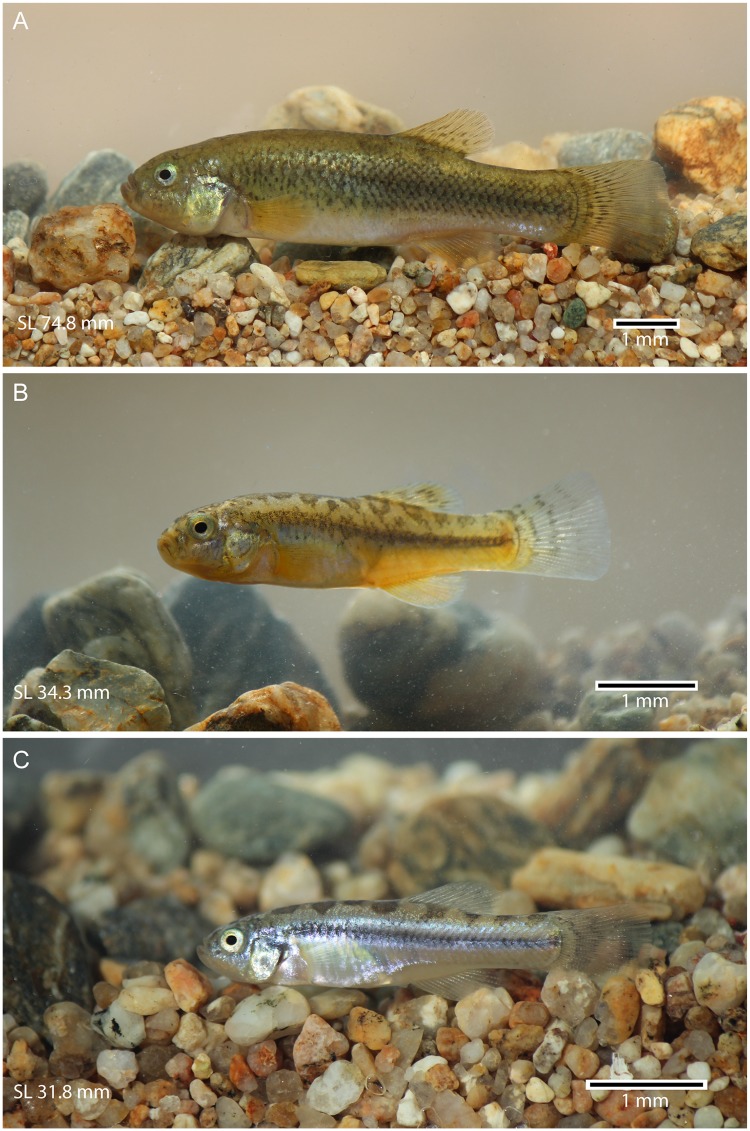
External views of Pseudorestias lirimensis gen. et sp. nov. illustrating different coloration patterns. Credit: Gloria Arratia et. al.
New species of fish seem to be described almost daily, but a new genus? That’s less common.
Of particular interest to killifish enthusiasts, scientists have introduced the new species and genus Pseudorestias lirimensis, hailing from the high plains of Chile (the Chilean Altiplano). The type location is the Chancacolla River. The new killifish species description, Morphological and taxonomic descriptions of a new genus and species of killifishes (Teleostei: Cyprinodontiformes) from the high Andes of northern Chile, was published by authors Gloria Arratia, Irma Vila, Claudia Jimena Guerrero, and Claudio Quezada-Romegialli, in the journal PLoS ONE on August 8th, 2017.
“Pseudorestias” is the chosen name for the genus, “in reference to the overall similarities with the genus Orestias.” According to Wikipedia, “Orestias is restricted to freshwater habitats at an altitude of 2,800-4,600m (9,200-15,100ft) in the Andes of central and southern Peru, western Bolivia, and northeastern Chile. Of the 45 recognized species, the majority are found in Lake Titicaca (including 23 endemics), with the remaining from other Altiplano lakes, rivers or springs.” (See References below.)

Main course of Chancacolla River, type locality of the new killifish, Pseudorestias lirimensis. Credit: Gloria Arratia et. al.
While it’s unlikely that this fish would show up in the aquarium hobby, Killifish fanatics could surprise us; freshwater aquarists seem ever more willing, year after year, to step out of their comfort zones and the traditional mainstream aquarium staples, looking to break new ground.
Some general notes of interest for the would-be aquarist:
- This species is highly sexually dimorphic; males are considerably smaller, and slimmer than females.
- The coloration of this species is highly variable, as demonstrated in the accompanying photographs.
- The authors describe the water chemistry of the type location as “a predominant sodium sulfated wetland (Na<Ca<K<Mg).” Water chemistry samples from regional wetlands suggest saline areas with high dissolved solids and high pH levels.
- La Paz, Belize, is the closest city, some 350+ miles away by road. While its climate may provide some very general insights, a lot can change over that distance.
- Given the general region’s climate, it’s probably best to initially think of these as temperate desert fish. Water temps for area wetlands taken in November (summer in the southern hemisphere) were 22.1 C – 24.1 C (approximately 72-75F); no complete seasonal water temperature profile exists.
- Coming from an arid high plain, where the region averages 12,300 feet above sea level, air temps vary widely and seasonally, and presumably, water temps would vary in kind. While exact data doesn’t seem to be available, by combining reported data from Wikipedia and the website This Is Chile, it’s probably fair to presume that daytime temps above 24C (75F) are rare, and the coldest winter night might come in at -20C (-4F).

Pseudorestias lirimensis gen. et sp. nov. in lateral view. Three females are shown. Credit: Gloria Arratia et. al.
In summation, this new killifish is a new example of a fish taking up residence in potentially harsh conditions, not unlike the Soda Lake Cichlids from Africa or the Desert Pupfish found in the southwestern United States. It’s a curiosity for sure. You can read the full species description for Pseudorestias limirensis in the open access article on PLoS ONE.
References:
Arratia, Gloria et al. “Morphological and Taxonomic Descriptions of a New Genus and Species of Killifishes (Teleostei: Cyprinodontiformes) from the High Andes of Northern Chile.” Ed. Paul Eckhard Witten. PLoS ONE 12.8 (2017): e0181989. PMC. Web. 17 Aug. 2017. https://www.ncbi.nlm.nih.gov/pmc/articles/PMC5549709/figure/pone.0181989.g018/
Additional References:
Orestias (Genus): https://en.wikipedia.org/wiki/Orestias_(fish)
Altiplano on Wikipedia: https://en.wikipedia.org/wiki/Altiplano
Chilean Climate via This Is Chile: https://www.thisischile.cl/the-climate-of-chile/?lang=en
Wetland Chemistry: Scott, Sergio et al. “Microbial diversity and trophic components of two high altitude wetlands of the Chilean Altiplano.” Gayana (Concepc.), Concepción , v. 79, n. 1, p. 45-56, June 2015 . http://www.scielo.cl/scielo.php?script=sci_arttext&pid=S0717-65382015000100006&lng=en&nrm=iso&tlng=en





